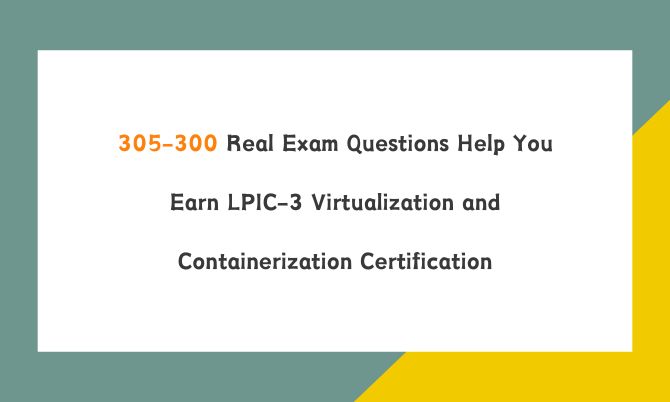The LPIC-3 Virtualization and Containerization certification represents the highest level of expertise in Linux systems administration, and 305-300 exam is required to take and pass. This certification is designed for professionals who work in enterprise-level environments, focusing on the deployment, management, and maintenance of virtualization and containerization technologies. The LPIC-3 certification is aimed at seasoned Linux professionals who have already earned their LPIC-1 and LPIC-2 certifications. LPIC-3 is highly respected in the industry as a distribution-neutral certification, demonstrating your ability to manage and administer Linux systems at an enterprise level. Study the latest 305-300 real exam questions from Testpassport will be your best preparation material to pass 305-300 exam easily. Understanding 305-500 exam prerequisites, exam requirements and objectives is also an important step.

To earn the LPIC-3 Virtualization and Containerization certification, candidates must first hold an active LPIC-2 certification. Once this prerequisite is met, they need to pass the 305-300 exam, which specifically tests knowledge and skills in virtualization and containerization technologies.
The 305-300 exam is a 90-minute test consisting of 60 multiple-choice and fill-in-the-blank questions. The 305-300 exam is available in English and Japanese and must be retaken every five years to maintain certification validity.
The 305-300 exam covers three main areas: Full Virtualization, Container Virtualization, and Virtual Machine Deployment and Provisioning. Each area focuses on different technologies and concepts crucial for managing Linux-based virtual environments.
Full Virtualization
Understand virtualization concepts and terminology, including hypervisors like Xen, QEMU, and libvirt, and key features like snapshotting and resource limits.
Know how to install, configure, maintain, migrate, and troubleshoot Xen.
Manage QEMU installations, start instances, handle snapshots, and troubleshoot networking and storage issues.
Use libvirt to manage virtualization platforms, including connections, domains, storage pools, and migrations.
Manage virtual machine disk images with tools, and understand formats like raw images, qcow2, and VMDK.
Container Virtualization
Understand container virtualization fundamentals, including Linux components like namespaces, cgroups, and security mechanisms.
Manage LXC containers and use LXD profiles.
Understand Docker architecture, manage containers and images, handle networking, logging, and volumes, and create images with Dockerfiles.
Understand container orchestration with tools like Docker Swarm, Kubernetes, and Helm, and be aware of platforms like OpenShift and Rancher.
VM Deployment and Provisioning
Know common cloud tools like OpenStack and Terraform, and be familiar with CloudStack and Eucalyptus.
Use Packer to create system images for various environments.
Use cloud-init to configure VMs, install software, manage SSH logins, and integrate into system images.
Use Vagrant to provision VMs, manage boxes from Atlas, create and run Vagrantfiles, and manage multi-machine setups.
LPIC-3 Virtualization and Containerization certification 305-300 exam sample questions can help you familiar with the type of questions. Share some 305-300 exam sample questions below.
1.Which of the following statements are true regarding VirtualBox?
A. It is a hypervisor designed as a special kernel that is booted before the first regular operating system starts.
B. It only supports Linux as a guest operating system and cannot run Windows inside a virtual machine.
C. It requires dedicated shared storage, as it cannot store virtual machine disk images locally on block devices of the virtualization host.
D. It provides both a graphical user interface and command line tools to administer virtual machines.
E. It is available for Linux only and requires the source code of the currently running Linux kernel to be available.
Answer: D
2.Which of the following statements are true regarding a Pod in Kubernetes? (Choose two.)
A. All containers of a Pod run on the same node.
B. Pods are always created automatically and cannot be explicitly configured.
C. A Pod is the smallest unit of workload Kubernetes can run.
D. When a Pod fails, Kubernetes restarts the Pod on another node by default.
E. systemd is used to manage individual Pods on the Kubernetes nodes.
Answer: A C
3.Which of the following statements are true about sparse images in the context of virtual machine storage? (Choose two.)
A. Sparse images are automatically shrunk when files within the image are deleted.
B. Sparse images may consume an amount of space different from their nominal size.
C. Sparse images can only be used in conjunction with paravirtualization.
D. Sparse images allocate backend storage at the first usage of a block.
E. Sparse images are automatically resized when their maximum capacity is about to be exceeded.
Answer: B D
4.What is the purpose of capabilities in the context of container virtualization?
A. Map potentially dangerous system calls to an emulation layer provided by the container virtualization.
B. Restrict the disk space a container can consume.
C. Enable memory deduplication to cache files which exist in multiple containers.
D. Allow regular users to start containers with elevated permissions.
E. Prevent processes from performing actions which might infringe the container.
Answer: E
5.What is the purpose of thekubeletservice in Kubernetes?
A. Provide a command line interface to manage Kubernetes.
B. Build a container image as specified in a Dockerfile.
C. Manage permissions of users when interacting with the Kubernetes API.
D. Run containers on the worker nodes according to the Kubernetes configuration.
E. Store and replicate Kubernetes configuration data.
Answer: D
The LPIC-3 Virtualization and Containerization certification is a comprehensive validation of a Linux professional's ability to manage enterprise-level virtual environments. With the rapid adoption of virtualization and containerization technologies across industries, this certification provides a significant career advantage for IT professionals. By mastering the topics covered in the 305-300 exam, candidates not only gain a prestigious certification but also enhance their practical skills, enabling them to efficiently manage and deploy complex Linux-based virtual and containerized systems.